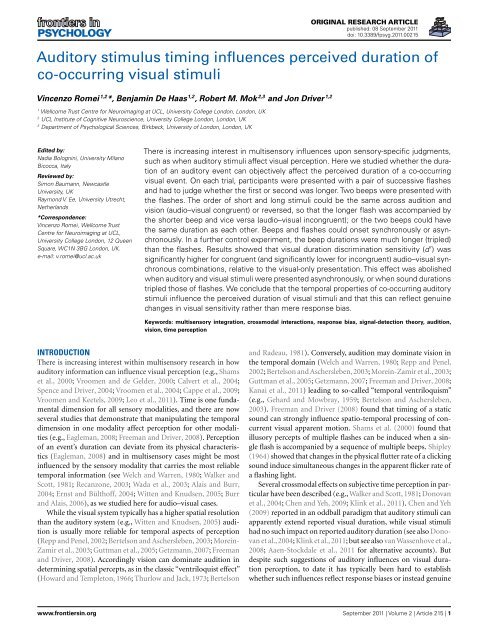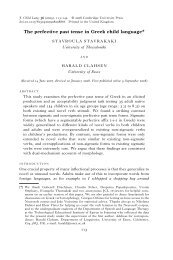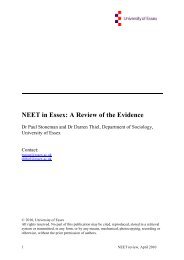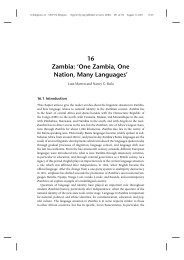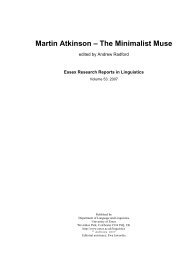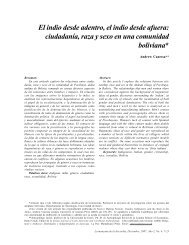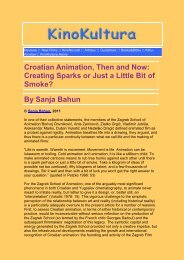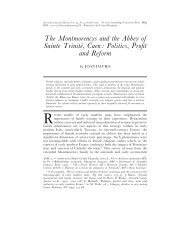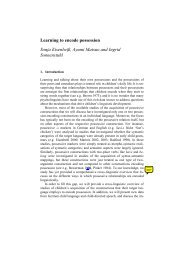Auditory stimulus timing influences perceived ... - ResearchGate
Auditory stimulus timing influences perceived ... - ResearchGate
Auditory stimulus timing influences perceived ... - ResearchGate
You also want an ePaper? Increase the reach of your titles
YUMPU automatically turns print PDFs into web optimized ePapers that Google loves.
ORIGINAL RESEARCH ARTICLE<br />
published: 08 September 2011<br />
doi: 10.3389/fpsyg.2011.00215<br />
<strong>Auditory</strong> <strong>stimulus</strong> <strong>timing</strong> <strong>influences</strong> <strong>perceived</strong> duration of<br />
co-occurring visual stimuli<br />
Vincenzo Romei 1,2 *, Benjamin De Haas 1,2 , Robert M. Mok 2,3 and Jon Driver 1,2<br />
1<br />
Wellcome Trust Centre for Neuroimaging at UCL, University College London, London, UK<br />
2<br />
UCL Institute of Cognitive Neuroscience, University College London, London, UK<br />
3<br />
Department of Psychological Sciences, Birkbeck, University of London, London, UK<br />
Edited by:<br />
Nadia Bolognini, University Milano<br />
Bicocca, Italy<br />
Reviewed by:<br />
Simon Baumann, Newcastle<br />
University, UK<br />
Raymond V. Ee, University Utrecht,<br />
Netherlands<br />
*Correspondence:<br />
Vincenzo Romei, Wellcome Trust<br />
Centre for Neuroimaging at UCL,<br />
University College London, 12 Queen<br />
Square, WC1N 3BG London, UK.<br />
e-mail: v.romei@ucl.ac.uk<br />
There is increasing interest in multisensory <strong>influences</strong> upon sensory-specific judgments,<br />
such as when auditory stimuli affect visual perception. Here we studied whether the duration<br />
of an auditory event can objectively affect the <strong>perceived</strong> duration of a co-occurring<br />
visual event. On each trial, participants were presented with a pair of successive flashes<br />
and had to judge whether the first or second was longer. Two beeps were presented with<br />
the flashes. The order of short and long stimuli could be the same across audition and<br />
vision (audio–visual congruent) or reversed, so that the longer flash was accompanied by<br />
the shorter beep and vice versa (audio–visual incongruent); or the two beeps could have<br />
the same duration as each other. Beeps and flashes could onset synchronously or asynchronously.<br />
In a further control experiment, the beep durations were much longer (tripled)<br />
than the flashes. Results showed that visual duration discrimination sensitivity (d ′ )was<br />
significantly higher for congruent (and significantly lower for incongruent) audio–visual synchronous<br />
combinations, relative to the visual-only presentation. This effect was abolished<br />
when auditory and visual stimuli were presented asynchronously, or when sound durations<br />
tripled those of flashes. We conclude that the temporal properties of co-occurring auditory<br />
stimuli influence the <strong>perceived</strong> duration of visual stimuli and that this can reflect genuine<br />
changes in visual sensitivity rather than mere response bias.<br />
Keywords: multisensory integration, crossmodal interactions, response bias, signal-detection theory, audition,<br />
vision, time perception<br />
INTRODUCTION<br />
There is increasing interest within multisensory research in how<br />
auditory information can influence visual perception (e.g., Shams<br />
et al., 2000; Vroomen and de Gelder, 2000; Calvert et al., 2004;<br />
Spence and Driver, 2004; Vroomen et al., 2004; Cappe et al., 2009;<br />
Vroomen and Keetels, 2009; Leo et al., 2011). Time is one fundamental<br />
dimension for all sensory modalities, and there are now<br />
several studies that demonstrate that manipulating the temporal<br />
dimension in one modality affect perception for other modalities<br />
(e.g., Eagleman, 2008; Freeman and Driver, 2008). Perception<br />
of an event’s duration can deviate from its physical characteristics<br />
(Eagleman, 2008) and in multisensory cases might be most<br />
influenced by the sensory modality that carries the most reliable<br />
temporal information (see Welch and Warren, 1980; Walker and<br />
Scott, 1981; Recanzone, 2003; Wada et al., 2003; Alais and Burr,<br />
2004; Ernst and Bülthoff, 2004; Witten and Knudsen, 2005; Burr<br />
and Alais, 2006), as we studied here for audio–visual cases.<br />
While the visual system typically has a higher spatial resolution<br />
than the auditory system (e.g., Witten and Knudsen, 2005) audition<br />
is usually more reliable for temporal aspects of perception<br />
(Repp and Penel, 2002; Bertelson and Aschersleben, 2003; Morein-<br />
Zamir et al., 2003; Guttman et al., 2005; Getzmann, 2007; Freeman<br />
and Driver, 2008). Accordingly vision can dominate audition in<br />
determining spatial percepts, as in the classic “ventriloquist effect”<br />
(Howard and Templeton, 1966; Thurlow and Jack, 1973; Bertelson<br />
and Radeau, 1981). Conversely, audition may dominate vision in<br />
the temporal domain (Welch and Warren, 1980; Repp and Penel,<br />
2002; Bertelson and Aschersleben,2003; Morein-Zamir et al.,2003;<br />
Guttman et al., 2005; Getzmann, 2007; Freeman and Driver, 2008;<br />
Kanai et al., 2011) leading to so-called “temporal ventriloquism”<br />
(e.g., Gehard and Mowbray, 1959; Bertelson and Aschersleben,<br />
2003). Freeman and Driver (2008) found that <strong>timing</strong> of a static<br />
sound can strongly influence spatio-temporal processing of concurrent<br />
visual apparent motion. Shams et al. (2000) found that<br />
illusory percepts of multiple flashes can be induced when a single<br />
flash is accompanied by a sequence of multiple beeps. Shipley<br />
(1964) showed that changes in the physical flutter rate of a clicking<br />
sound induce simultaneous changes in the apparent flicker rate of<br />
a flashing light.<br />
Several crossmodal effects on subjective time perception in particular<br />
have been described (e.g.,Walker and Scott, 1981; Donovan<br />
et al., 2004; Chen and Yeh, 2009; Klink et al., 2011). Chen and Yeh<br />
(2009) reported in an oddball paradigm that auditory stimuli can<br />
apparently extend reported visual duration, while visual stimuli<br />
had no such impact on reported auditory duration (see also Donovan<br />
et al.,2004; Klink et al.,2011; but see also van Wassenhove et al.,<br />
2008; Aaen-Stockdale et al., 2011 for alternative accounts). But<br />
despite such suggestions of auditory <strong>influences</strong> on visual duration<br />
perception, to date it has typically been hard to establish<br />
whether such <strong>influences</strong> reflect response biases or instead genuine<br />
www.frontiersin.org September 2011 | Volume 2 | Article 215 | 1
Romei et al.<br />
<strong>Auditory</strong> <strong>timing</strong> <strong>influences</strong> visual duration<br />
changes in visual sensitivity, in signal-detection terms (Macmillan<br />
and Creelman, 1991).<br />
We sought to address this issue directly here. On each trial<br />
subjects were presented with two visual stimuli in succession (see<br />
Figure 1) and had to make a force-choice about which was longer,<br />
which had an objectively correct answer. The multisensory manipulation<br />
was that we could also present two sounds on each trial.<br />
In Experiment 1a each sound was presented simultaneously with<br />
a flash (see Figure 1). These were possible two durations for the<br />
flashes, both used on every single trial so that one flash (either the<br />
first or the second) was longer. The beep durations on a given trial<br />
could potentially agree with those for the two successive flashes<br />
(congruent condition). Alternatively the two sounds could have<br />
the reverse order of durations (incongruent condition), or else the<br />
same duration as each other (both sounds short, or both sounds<br />
long). We measured whether manipulating the auditory durations<br />
had an impact on objective performance in the visual duration<br />
discrimination task, analyzing this in terms of signal-detection<br />
theory.<br />
To determine whether any influence of auditory durations on<br />
visual duration judgments depended on synchrony between the<br />
multisensory events, in a control study (Experiment 1b) we misaligned<br />
the onsets of auditory and visual events (by 500 ms) to produce<br />
asynchronous control conditions. If the impact of auditory<br />
durations on visual duration perceptions reflects multisensory<br />
binding (e.g., see Meredith et al., 1987; Colonius and Diederich,<br />
2011), it should be eliminated or reduced in the asynchronous<br />
condition; whereas if instead it were simply to reflect a response<br />
bias (similar to the response that a blind observer might give<br />
when asked to report visual durations when only hearing sounds)<br />
the auditory influence should remain the same even in the new<br />
asynchronous case of Experiment 1b. Finally, in a further control<br />
situation (Experiment 2) we tripled the length of auditory durations<br />
relative to visual durations, reasoning that if auditory and<br />
visual durations mismatch sufficiently, there should be less genuine<br />
perceptual binding between them (whereas once again, the<br />
response bias of a strictly blind observer who only hears sounds,<br />
misreporting them as if they were seen, should remain the same).<br />
FIGURE 1|Schematic timelines representing conditions in Experiment<br />
1A and 1B. In Experiment 1A all corresponding auditory (red lines marked<br />
with label “AUD”) and visual (blue lines marked with label “VIS”) stimuli had<br />
the same onset (synchronous conditions) while in Experiment 1B visual<br />
stimuli always preceded auditory stimuli by 500 ms (asynchronous<br />
conditions). In both situations, each pair of stimuli within one modality was<br />
separated by a 1000-ms interval; the order of short and long stimuli could be<br />
the same across auditory and visual modalities (congruent) or reversed<br />
between them (incongruent). In the both-auditor-short condition, both<br />
successive sounds had the shorter visual duration (and vice versa for<br />
both-auditory-long). Finally a visual-only condition served as a baseline<br />
measure.<br />
Frontiers in Psychology | Perception Science September 2011 | Volume 2 | Article 215 | 2
Romei et al.<br />
<strong>Auditory</strong> <strong>timing</strong> <strong>influences</strong> visual duration<br />
EXPERIMENT 1<br />
Seventeen participants with a mean age of 26.29 (range 19–35)<br />
took part in the first experiment, nine female, one left-handed.<br />
All reported normal or corrected visual acuity and normal hearing.<br />
All gave written informed consent in accord with University<br />
College London ethics approval, were naïve to the purpose of the<br />
study and were paid for their time. One participant was excluded<br />
because she showed an inconsistent pattern in the visual titration<br />
(see below). Two more were excluded because their performance<br />
in the visual-only condition was at ceiling in the main experiments,<br />
leaving 14 participants in the sample.<br />
APPARATUS<br />
Stimuli were presented on a 21′ CRT display (Sony GDM-F520) in<br />
a darkened room. Participants sat with their head in a chin rest at<br />
65 cm viewing distance. Video resolution was 1600 × 1200, with<br />
screen refresh rate of 85 Hz. Two small stereo PC speakers were<br />
placed just in front of the monitor immediately on either side<br />
of it. Stimulus control and data recording were implemented on<br />
a standard PC, running E-Prime 2 Professional (Psychology Software<br />
tools, Inc., www.pstnet.com). Unspeeded manual two-choice<br />
responses were made using a standard PC keyboard.<br />
STIMULI<br />
Each visual <strong>stimulus</strong> comprised a white disk extending 1.2˚ in<br />
visual angle with its midpoint at 3˚ below a central fixation cross<br />
on a gray background. On each trial a pair of disks was flashing<br />
consecutively with varying durations from 55 to 165 ms.<br />
The auditory <strong>stimulus</strong> was a 900-Hz pure tone sampled at<br />
44.100 kHz with durations also varying from 55 to 165 ms. Sound<br />
level was measured with an audiometer and set to ∼70 dB(A).<br />
PROCEDURE<br />
Visual titration<br />
Only visual stimuli were presented during this part of the experiment.<br />
On each trial participants were presented with a pair of<br />
disks flashing in two consecutive time windows separated by an<br />
SOA of 1000 ms. While one of the two visual stimuli had a constant<br />
standard duration of 55 ms, the other was slightly longer, with its<br />
duration varying between 66 and 165 ms (10 possible incremental<br />
steps of one frame at 85 Hz, i.e., ∼11 ms). The latter <strong>stimulus</strong> type<br />
will be referred to as the“longer”<strong>stimulus</strong>. Each of the resulting 10<br />
pairings of standard and longer stimuli was repeated 10 times per<br />
block. Each participant completed two to three blocks. The pairwise<br />
order of standard and longer stimuli was counterbalanced<br />
between trials, with standard-longer or longer-standard pairwise<br />
sequences being equiprobable.<br />
On each trial participants were instructed to indicate whether<br />
the first or the second flash lasted longer, by pressing a corresponding<br />
button on the keyboard (“1” or “2”). This allowed us<br />
to identify the visual duration discrimination threshold for each<br />
participant individually. Threshold was defined as corresponding<br />
to the increase in duration for the longer <strong>stimulus</strong> whose duration<br />
allowed correct identification of it as longer in ∼75% of cases. As<br />
it turned out, for the selected threshold <strong>stimulus</strong> participants were<br />
able to discriminate differences of durations correctly in 73.78<br />
(±1.6 SE)% of cases for those <strong>stimulus</strong> pairings containing the<br />
longer <strong>stimulus</strong> that was identified as threshold. The average duration<br />
of the longer stimuli identified as threshold was 103.4 (±3.97<br />
SE) ms duration, for the visual disks used.<br />
MAIN EXPERIMENT 1<br />
In each trial of the main experiment, participants were presented<br />
with the pair of visual stimuli previously identified as around<br />
threshold from the titration task. Again, the order of standard<br />
and longer visual <strong>stimulus</strong> was counterbalanced and equiprobable,<br />
with participants again asked to indicate which of the two consecutive<br />
flashes lasted longer. But the main experiment now consisted<br />
of 10 conditions (5 in Experiment 1a, and 5 in Experiment 1b, with<br />
these 10 all intermingled but presented separately here for ease of<br />
exposition). These 10 conditions differed with regard to whether,<br />
when, and how any sounds were presented with the flashes. Participants<br />
were emphatically instructed to ignore all sounds played<br />
during the experiment and to judge only the duration of the visual<br />
stimuli.<br />
Two pure tone durations were selected for each participant –<br />
one lasting 55 ms and thus matching the standard visual <strong>stimulus</strong><br />
in duration, the other auditory duration matching the participantspecific<br />
longer visual <strong>stimulus</strong> identified as threshold during the<br />
preceding visual titration task. These two pure tones were then<br />
combined with the flashes according to condition. There were two<br />
main classes of conditions: potentially synchronous (Experiment<br />
1a) or asynchronous (Experiment 1b). In the potentially synchronous<br />
conditions, tone onset was temporally aligned with the visual<br />
onsets; whereas in the potentially asynchronous conditions, the<br />
onset of tones was delayed for 500 ms (thus 180˚ out of “phase” if<br />
one considers the pair of visual stimuli as a cycle, for which 180˚<br />
yields the maximum possible phase offset) relative to flash onsets.<br />
In either of the potentially synchronous or asynchronous situations,<br />
there were five possible conditions: audio–visual congruent<br />
(same order of durations in the two modalities), audio–visual<br />
incongruent (opposite orders of durations in the two modalities),<br />
both-long auditory stimuli, both-short auditory stimuli, or<br />
a purely visual condition (c.f. Figure 1). The purely visual condition<br />
was of course actually equivalent for “synchronous” and<br />
“asynchronous” conditions, corresponding to the same condition<br />
arbitrarily divided into two separate datasets (random halves of<br />
the visual-only trials per participant), so as to a 5 × 2 factorial<br />
analysis of variance (ANOVA) on the data; see below.<br />
Each block contained 10 repetitions for each of the 10 conditions<br />
in a randomized order. Every participant repeated three to<br />
four of these blocks.<br />
DATA ANALYSIS<br />
For each participant we computed visual sensitivity (d ′ ) and criterion<br />
(c) for the duration discrimination task, for each condition,<br />
using standard formulae as in Macmillan and Creelman (1997),<br />
namely:<br />
d ′ = z(H) − z(F)<br />
and<br />
c= −[z (H) +z(F)]/2<br />
www.frontiersin.org September 2011 | Volume 2 | Article 215 | 3
Romei et al.<br />
<strong>Auditory</strong> <strong>timing</strong> <strong>influences</strong> visual duration<br />
where z(H) stands for the z-transform of the hit rate, while z(F)<br />
stands for the z-transform of the false-alarm rate. For any cases<br />
in which false-alarm rates were zero, we followed the conservative<br />
convention (as recommended by Snodgrass and Corwin, 1988;<br />
Macmillan and Creelman, 1991; c.f. Sarri et al., 2006) of adding a<br />
count of 0.5 to all cells within a single analysis.<br />
d ′ and criterion were analyzed using repeated-measures<br />
ANOVA, with SYNCHRONY (synchronous/asynchronous) and<br />
audio–visual CONDITION (Congruent; Incongruent; Short<br />
sounds; Long sounds, Purely visual) as within-subjects factors;<br />
followed up by pairwise t-tests where appropriate.<br />
RESULTS<br />
The sensitivity (d ′ ) results are shown in Figure 2A (synchronous<br />
conditions) and Figure 2B (asynchronous conditions), as<br />
group means with SE. Recall that synchronous/asynchronous is a<br />
dummy factor solely for the visual-only condition, which was split<br />
randomly into two separate datasets. Note the higher sensitivity<br />
specifically in the synchronous audio–visual congruent condition<br />
(Figure 2A, leftmost bar). The overall 5 × 2 ANOVA showed a<br />
main effect of SYNCHRONY [F(1,13) = 12.09, p < 0.01], a significant<br />
main effect of audio–visual CONDITION [F(4,52) = 6.68,<br />
p < 0.001] and critically a significant interaction between these<br />
two factors [F(4,52) = 5.96, p < 0.001].<br />
To identify the source of the interaction, first two separate<br />
one-way ANOVAs were performed for synchronous or<br />
asynchronous datasets, with the five-level factor of condition.<br />
While none of asynchronous conditions differed from each other<br />
[F(4,52) = 0.56, p = 0.69 for the main effect], the synchronous<br />
conditions did [F(4,52) = 10.91, p < 0.00001]. Exploratory pairwise<br />
t-tests for the asynchronous conditions confirmed no significant<br />
differences between any (all p > 0.20). Pairwise t-tests<br />
for the synchronous conditions showed that sensitivity in the<br />
synchronous audio–visual congruent condition (d ′ = 1.93 ± 0.23<br />
SE) was significantly higher than in all the other conditions,<br />
as follows: (i) versus the synchronous audio–visual incongruent<br />
condition [d ′ = 0.20 ± 0.15 SE; t(13) = 4.93; p < 0.001]; (ii)<br />
versus the both-auditory-short condition [d ′ = 1.07 ± 0.16 SE;<br />
t(13) = 3.63; p < 0.01]; (iii) versus the both-auditory-long condition<br />
[d ′ = 1.11 ± 0.19 SE; t(13) = 3.0, p = 0.01]. The trend for the<br />
somewhat lower d ′ overall in the asynchronous than synchronous<br />
experiment did not approach significance.<br />
When compared to the visual-only baseline measure<br />
(d ′ = 1.01 ± 0.18 SE), we found that: (i) visual duration discrimination<br />
was significantly enhanced in the synchronous audio–<br />
visual congruent condition [t(13) =−3.38; p < 0.01]; (ii) was<br />
significantly impaired in the synchronous audio–visual incongruent<br />
condition [t(13) = 3.44, p < 0.01]; (iii) was not significantly<br />
affected in the both-auditory-long or short conditions (all<br />
p > 0.71).<br />
A comparable two-way ANOVA on criterion scores instead<br />
revealed no significant results [main effect of SYNCHRONY<br />
(F(1,13) = 4.17, p = 0.07); main effect of audio–visual CONDI-<br />
TION (F(4,52) = 0.35, p = 0.83); interaction between the two<br />
(F(4,52) = 1.10, p = 0.36); all n.s.].<br />
DISCUSSION<br />
In Experiment 1 we found that objective duration discrimination<br />
for visual stimuli was objectively modulated by the duration of cooccurring<br />
auditory stimuli, but only when those auditory stimuli<br />
were synchronous with the visual events, rather than being delayed<br />
by 500 ms. Specifically, visual duration discrimination sensitivity<br />
(d ′ ) was enhanced for congruent-duration, synchronous auditory<br />
stimuli but decreased for incongruent-duration, synchronous<br />
auditory stimuli. Neither a sensitivity enhancement nor a sensitivity<br />
decrease could be observed for the asynchronous conditions, in<br />
which the sounds were now delayed by 500 ms so as to be (maximally)<br />
out-of-phase with the flashes. This elimination of the effect<br />
for the asynchronous case, together with the observed impact on<br />
d ′ (rather than criterion) for the synchronous cases, indicates a<br />
FIGURE 2 | Mean visual duration discrimination sensitivity (d ′ ), SEM<br />
indicated) for each condition in Experiment 1a (A) and 1b (B). Asterisks in<br />
1a indicate significant differences relative to the synchronous–congruent<br />
condition that gave best performance (*p < 0.05, **p < 0.01, ***p < 0.001),<br />
see leftmost bar in left graph. None of the pairwise contrasts were significant<br />
for the asynchronous conditions (see right graph).<br />
Frontiers in Psychology | Perception Science September 2011 | Volume 2 | Article 215 | 4
Romei et al.<br />
<strong>Auditory</strong> <strong>timing</strong> <strong>influences</strong> visual duration<br />
genuine multisensory impact on visual perception, rather than a<br />
mere response bias as might be evident if a blind observer had to<br />
guess the response based solely on the sounds.<br />
We suggest that the strong effect of auditory duration on perception<br />
of synchronous visual events reflects crossmodal binding<br />
between them (e.g., see also Meredith et al., 1987; Vroomen and<br />
Keetels, 2010; Colonius and Diederich, 2011), plus weighting of<br />
the auditory duration when bound due to the higher precision<br />
of temporal coding for audition than vision (see Introduction).<br />
A visual event is evidently <strong>perceived</strong> as longer when co-occurring<br />
with a slightly longer auditory event that is parsed as part of the<br />
same, single multisensory event. But we reasoned that if this is<br />
indeed a genuine perceptual effect as we document, rather than<br />
merely a response bias, then there should presumably be a limit<br />
to how far a longer auditory event can “stretch” perception of a<br />
visual event. If the auditory event were to endure much, much<br />
longer than the corresponding visual event, it should become less<br />
plausible that they arise from the same single external crossmodal<br />
event, and the auditory influence should begin to wane. We tested<br />
this in Experiment 2.<br />
EXPERIMENT 2<br />
This study repeated the critical conditions where effects had<br />
been apparent in Experiment 1 (i.e., synchronous–congruent,<br />
synchronous–incongruent, plus visual-only baseline) except that<br />
now either the sounds had the same possible durations as the<br />
flashes, or else the sounds were tripled in duration such that<br />
they would no longer plausibly correspond to the flashes. A mere<br />
response bias, akin to a blind observer simply reporting the durations<br />
of the sounds, should lead to a similar outcome in either<br />
case; whereas the genuine perceptual effect we have documented<br />
should reduce (or even potentially disappear) in the mismatching<br />
tripled situation.<br />
METHODS<br />
Participants<br />
Fifteen new participants with a mean age of 24.53 (range 18–34)<br />
took part, seven females, one left-handed, all reporting normal or<br />
corrected visual acuity, and normal hearing.<br />
Apparatus and stimuli<br />
The setup was as for Experiment 1,but with less conditions and two<br />
new ones.We repeated the synchronous–congruent,synchronous–<br />
incongruent, and visual-only conditions. We also added two<br />
new conditions that were as for the synchronous–congruent and<br />
synchronous–incongruent except with tripled auditory durations.<br />
In these two new tripled conditions, each sound still onset simultaneously<br />
with each flash, but the sounds now lasted three times<br />
as long, so that with their much later offset they did not match the<br />
visual events so well.<br />
PROCEDURE<br />
Visual titration<br />
This aspect of the procedure was the same as in Experiment 1. On<br />
average, participants were able to discriminate durations correctly<br />
for 76.33 (±1.5 SE)% of cases for those <strong>stimulus</strong> pairings that<br />
contained the longer visual <strong>stimulus</strong> identified as threshold. The<br />
average duration of the longer visual stimuli identified as threshold<br />
was 94.5 (±3.49 SE) ms duration, so 49.5 ms longer than the<br />
standard <strong>stimulus</strong>, with the visual disks used.<br />
MAIN EXPERIMENT<br />
The procedure resembled Experiment 1, but with only five conditions,<br />
two of which were new. The purely visual baseline,<br />
synchronous–congruent, and synchronous–incongruent conditions<br />
were as before. The two new conditions were tripledsound-synchronous–congruent<br />
and tripled-sound-synchronous–<br />
incongruent condition. These were exactly like their untripled<br />
counterpart, except that the duration of each sound was three<br />
times as long.<br />
DATA ANALYSIS<br />
For each participant and condition we computed sensitivity (d ′ )<br />
and criterion (c) for each <strong>stimulus</strong> condition as in Experiment 1.<br />
d ′ or criterion for the four audio–visual conditions were analyzed<br />
using repeated-measures two-way ANOVA, with SOUND<br />
LENGTH (tripled or untripled) and audio–visual duration CON-<br />
GRUENCY (congruent versus incongruent) as factors. In addition<br />
pairwise t-tests compared performance in the purely visual<br />
baseline against the remaining conditions.<br />
RESULTS<br />
The sensitivity (d ′ ) results are shown in Figure 3, as group means<br />
with SE. Note the higher sensitivity in the audio–visual untripled<br />
synchronous–congruent condition (leftmost bar), replicating the<br />
effects obtained in Experiment 1a (c.f. Figure 2A).<br />
The two-way ANOVA showed no main effect of SOUND<br />
LENGTH [F(1,14) = 1.94, p = 0.18], a significant main effect of<br />
CONGRUENCY [F(1,14) = 49.33, p < 0.00001] and a significant<br />
interaction between these two factors [F(1,14) = 10.99, p < 0.01],<br />
because the congruent/incongruent difference was larger in<br />
the untripled than tripled case. Sensitivity in the audio–visual<br />
untripled synchronous–congruent condition (d ′ = 2.07 ± 0.16<br />
SE) was significantly higher than in all the other conditions,<br />
as follows: (i) versus the visual-only duration condition<br />
[d ′ = 1.58 ± 0.16 SE; t(14) = 2.86; p = 0.013]; (ii) versus the<br />
tripled congruent condition [d ′ = 1.72 ± 0.18 SE; t(14) = 2.82;<br />
p = 0.014]; (iii) versus the untripled incongruent condition<br />
[d ′ = 0.11 ± 0.26 SE; t(14) = 8.85; p < 0.000001]; (iv) versus the<br />
tripled incongruent condition [d ′ = 0.82 ± 0.25 SE; t(14) = 4.8,<br />
p < 0.001].<br />
Thus, by prolonging the duration of the auditory stimuli to<br />
triple that of the visual stimuli, the significant enhancement (relative<br />
to visual-only baseline) obtained for the congruent audio–<br />
visual durations was abolished. While even triple-duration auditory<br />
stimuli still produced some sensitivity decrease for incongruent<br />
stimuli, even this remaining decrease was still significantly<br />
reduced for the tripled versus untripled case [t(14) =−2.69,<br />
p = 0.018].<br />
A comparable analysis of criterion scores instead revealed no<br />
significant results [e.g., for the two-way ANOVA, main effects<br />
of SOUND LENGTH (F(1,14) = 3.29, p = 0.09); main effect of<br />
CONGRUENCY (F(1,14) = 0.002, p = 0.96); interaction between<br />
the two (F(1,14) = 2.15, p = 0.16), all n.s.].<br />
www.frontiersin.org September 2011 | Volume 2 | Article 215 | 5
Romei et al.<br />
<strong>Auditory</strong> <strong>timing</strong> <strong>influences</strong> visual duration<br />
FIGURE 3 | Mean visual duration discrimination sensitivity (d ′ ), SEM<br />
indicated) for each condition in Experiment 2. Asterisks above bars point<br />
to significant differences relative to the visual-only baseline, with the latter<br />
represented here by the orange dashed line with SEM shading. The<br />
significant enhancement or decrease of sensitivity, for the untripled<br />
congruent and incongruent conditions (respectively) replicates the findings<br />
of Experiment 1a. These effects were eliminated or reduced (respectively)<br />
for the corresponding two new tripled conditions, in which a sound still<br />
onset concurrently with each flash, but the sounds now were three times<br />
as long.<br />
DISCUSSION<br />
We replicated the results of Experiment 1a for the shared conditions<br />
in Experiment 2, showing significant enhancement of<br />
objective visual duration discrimination sensitivity (d ′ )bycongruent<br />
auditory stimuli and a significant decrease of sensitivity<br />
for incongruent stimuli. The new finding was that the sensitivity<br />
enhancement for congruent stimuli (i.e., same pairwise successive<br />
order of longer and shorter) relative to the visual-only<br />
baseline was completely abolished for prolonged auditory stimuli<br />
that onset concurrently with the visual flashes but endured three<br />
times longer. Some sensitivity decrease for incongruent audio–<br />
visual pairings remained but at a significantly reduced level in the<br />
tripled-sound-duration case. These results show that the impact<br />
of auditory durations on visual duration discrimination is larger<br />
when the sounds and flashes endure for a similar order of magnitude,<br />
being significantly diminished when the sounds endure three<br />
times longer than the flashes.<br />
GENERAL DISCUSSION<br />
In two experiments we tested the influence of sound duration<br />
on objective discrimination of the duration of visual events. Our<br />
results accord with but go beyond previous reports (e.g., Walker<br />
and Scott, 1981; Donovan et al., 2004; Chen and Yeh, 2009; Klink<br />
et al., 2011) that auditory stimuli can impact significantly on judgments<br />
for the duration of co-occurring visual stimuli. The new<br />
findings extend previous work by showing that: (1) not only can<br />
incongruent auditory stimuli significantly impair objective visual<br />
performance, but congruent auditory stimuli can benefit visual<br />
duration judgments; (2) this applies for visual sensitivity (d ′ )to<br />
visual duration in signal-detection terms, rather than affecting<br />
mere response bias or criterion; (3) this impact of auditory duration<br />
on perception of visual duration depends on whether the<br />
audio–visual onsets are synchronous, being eliminated when the<br />
sounds lagged here; (4) it also depends on whether the auditory<br />
and visual events are similar in length, being reduced, or eliminated<br />
when the sounds are triple the duration of corresponding<br />
visual events.<br />
A previous study by Donovan et al. (2004) used a similar<br />
approach to ours. They investigated the influence of task-irrelevant<br />
auditory information on a visual task, but with participants judging<br />
whether two sequential visual events were presented for the<br />
same or different lengths of time. They found a similar trend to<br />
the present pattern for congruent versus incongruent audio–visual<br />
conditions, and their effect was abolished for asynchronous conditions,<br />
reminiscent of the present Experiment 1b. But Donovan<br />
et al. (2004) did not titrate the duration of visual stimuli to a<br />
threshold level; did not present a visual-only condition to provide<br />
a baseline for assessing any multisensory benefit or cost; did not<br />
calculate signal-detection scores.<br />
More recently, Klink et al. (2011) extensively tested crossmodal<br />
<strong>influences</strong> on duration perception, confirming auditory<br />
over visual dominance for time perception. These authors adopted<br />
a duration discrimination task, similar to the one presented here.<br />
In line with our results, they found a reduction in visual duration<br />
discrimination accuracy with incongruent auditory stimuli.<br />
But they did not test the effect of audio–visual congruent stimuli,<br />
and their control for possible response biases was very different<br />
to our own (a grouping experiment, Experiment 5 in Klink<br />
et al., 2011). Our findings accord with such prior work (see also<br />
Introduction) in showing a clear influence of audition on visual<br />
duration judgments. We show in signal-detection terms that visual<br />
d ′ for duration discrimination can not only be impaired by incongruent<br />
auditory <strong>timing</strong> information, but for the first time, also<br />
significantly enhanced by congruent auditory information; plus<br />
we document some of the boundary conditions for this [in terms<br />
not only of synchronous onset across the modalities (see Experiment<br />
1 here) but also in terms of fairly well-matching duration<br />
scale (see Experiment 2 here)].<br />
How could such auditory <strong>influences</strong> over visual duration perception<br />
arise? An extensive literature on the many possible mechanisms<br />
for time perception has built up (for recent reviews, see<br />
Ivry and Schlerf, 2008; Grondin, 2010). One long tradition in<br />
the field of time perception posits the presence of central mechanisms<br />
for time estimation, such as an internal clock or clocks<br />
(e.g., Ivry and Richardson, 2002; Rosenbaum, 2002; Schöner, 2002;<br />
Wing, 2002). Some research suggests that such central-clock(s)<br />
might operate supramodally. In apparent support of this view are<br />
findings that several brain areas (e.g., see Ivry and Keele, 1989;<br />
Harrington et al., 1998; Rao et al., 2001; Leon and Shadlen, 2003;<br />
Coull et al., 2004; Bueti et al., 2008) are implicated in estimation<br />
and representation of time independently from the sensory<br />
modality of the stimuli in question, although it should be noted<br />
that some of the time judgments used were on longer scales than<br />
here.<br />
Frontiers in Psychology | Perception Science September 2011 | Volume 2 | Article 215 | 6
Romei et al.<br />
<strong>Auditory</strong> <strong>timing</strong> <strong>influences</strong> visual duration<br />
Other authors have argued that there may be no need to invoke<br />
internal “clocks” to describe some <strong>timing</strong> behaviors (e.g., Zeiler,<br />
1999; Jantzen et al., 2005; Karmarkar and Buonomano, 2007; Ivry<br />
and Schlerf, 2008). Recent findings in the field of visual perception,<br />
for example, have led to the development of seemingly more<br />
modality-specific perspectives (e.g., Yarrow et al., 2001; Ghose and<br />
Maunsell, 2002; Morrone, 2005; Johnston et al., 2006; Shuler and<br />
Bear, 2006; Xuan et al., 2007), suggesting that estimates for the<br />
duration of visual signals could be embedded within the visual<br />
modality itself.<br />
Here we showed that visual duration sensitivity can be significantly<br />
impaired or enhanced by auditory stimuli that are likely<br />
to be parsed as reflecting the same external “event” as the affected<br />
visual event. The central-clock perspective might consider this to<br />
arise at some internal <strong>timing</strong> process that is shared between modalities.<br />
On the other hand, our results might also be reconciled with<br />
visual duration judgments arising within visual cortex itself, provided<br />
it is acknowledged that auditory can also impact upon visual<br />
cortex (for which an increasing body of evidence now exists; e.g.,<br />
Martuzzi et al., 2007; Romei et al., 2007, 2009; Wang et al., 2008;<br />
Bolognini et al., 2010; Cappe et al., 2010; Noesselt et al., 2010;<br />
Bolognini and Maravita, 2011; c.f. Ghazanfar and Schroeder, 2006;<br />
Driver and Noesselt, 2008 for extensive review). It would be useful<br />
to combine the present behavioral paradigm with neural measures<br />
in future work; and also to study the impact of neural disruptions,<br />
such as transcranial magnetic stimulation (TMS), targeting visual<br />
cortex or auditory cortex or heteromodal cortex (see Kanai et al.,<br />
2011). Other future extensions of our paradigm could investigate<br />
whether lagging auditory events by different parametric amounts<br />
in the asynchronous condition would lead to a graded or categorical<br />
change in results; and the possible impact of introducing<br />
asynchrony by making auditory events lead instead. Here we had<br />
lagged the sounds in our asynchronous condition by a full 500 ms,<br />
in order to generate the maximum 180˚ shift to visual and auditory<br />
events being “out-of-phase” in terms of the cycle we used.<br />
A further interesting question for future extensions of our paradigm<br />
concerns the possible role of attention in the multisensory<br />
effect on sensitivity that we have identified. Indeed there is now a<br />
growing literature on the possible role of attention in multisensory<br />
integration (see Sanabria et al., 2007; Talsma et al., 2010). Studies<br />
of some multisensory phenomena suggesting no role for attention<br />
(e.g., Bertelson et al., 2000); while others on different multisensory<br />
phenomena suggest a key attentional role (e.g., van Ee et al., 2009).<br />
Accordingly it is an empirical issue whether the new multisensory<br />
phenomena that we have uncovered may depend on attention or<br />
not. The present results already make clear that audio–visual integration<br />
can genuinely affect visual sensitivity (d ′ ) here, and that<br />
this depends on audio–visual synchrony.<br />
Finally, given the evidently perceptual nature of the objective<br />
improvements in visual duration discrimination that we observed<br />
here due to appropriately timed sounds, it would be intriguing to<br />
study whether a slightly longer sound paired with a concurrent<br />
visual event can not only extend the apparent duration of that<br />
visual event, but actually improve visual perception of its other<br />
(non-temporal) visual qualities, in a similar manner to the visual<br />
improvement found for a genuinely longer visual <strong>stimulus</strong> (see<br />
Berger et al., 2003).<br />
ACKNOWLEDGMENTS<br />
Vincenzo Romei, Benjamin De Haas, and Jon Driver were supported<br />
by the Wellcome Trust. Jon Driver is a Royal Society<br />
Anniversary Research Professor.<br />
REFERENCES<br />
Aaen-Stockdale, C., Hotchkiss, J.,<br />
Heron, J., and Whitaker, D. (2011).<br />
Perceived time is spatial frequency<br />
dependent. Vision Res. 51,<br />
1232–1238.<br />
Alais, D., and Burr, D. (2004). The ventriloquist<br />
effect results from nearoptimal<br />
bimodal integration. Curr.<br />
Biol. 14, 257–262.<br />
Berger, T. D., Martelli, M., and Pelli, D.<br />
G. (2003). Flicker flutter: is an illusory<br />
event as good as the real thing?<br />
J. Vis. 3, 406–412.<br />
Bertelson, P., and Aschersleben, G.<br />
(2003). Temporal ventriloquism:<br />
crossmodal interaction on the time<br />
dimension: 1. evidence from auditory<br />
– visual temporal order judgment.<br />
Int. J. Psychophysiol. 50,<br />
147–155.<br />
Bertelson, P., and Radeau, M. (1981).<br />
Cross-modal bias and perceptual<br />
fusion with auditory-visual spatial<br />
discordance. Percept. Psychophys. 29,<br />
578–584.<br />
Bertelson, P., Vroomen, J., de Gelder,<br />
B., and Driver, J. (2000). The ventriloquist<br />
effect does not depend<br />
on the direction of deliberate visual<br />
attention. Percept. Psychophys. 62,<br />
321–332.<br />
Bolognini, N., and Maravita, A. (2011).<br />
Uncovering multisensory processing<br />
through non-invasive brain stimulation.<br />
Front. Psychol. 2:46. doi:<br />
10.3389/fpsyg.2011.00046<br />
Bolognini, N., Senna, I., Maravita, A.,<br />
Pascual-Leone, A., and Merabet, L.<br />
B. (2010). <strong>Auditory</strong> enhancement<br />
of visual phosphene perception: the<br />
effect of temporal and spatial factors<br />
and of <strong>stimulus</strong> intensity. Neurosci.<br />
Lett. 477, 109–114.<br />
Bueti, D., Bahrami, B., and Walsh, V.<br />
(2008). The sensory and association<br />
cortex in time perception. J. Cogn.<br />
Neurosci. 20, 1–9.<br />
Burr, D., and Alais, D. (2006). Combining<br />
visual and auditory information.<br />
Prog. Brain Res. 155, 243–258.<br />
Calvert,G. A.,Spence,C.,and Stein,B. E.<br />
(eds). (2004). The Handbook of Multisensory<br />
Processes. Cambridge: MIT<br />
Press.<br />
Cappe, C., Thut, G., Romei,V., and Murray,<br />
M. M. (2009). Selective integration<br />
of auditory-visual looming<br />
cues by humans. Neuropsychologia<br />
47, 1045–1052.<br />
Cappe, C., Thut, G., Romei, V., and<br />
Murray, M. M. (2010). <strong>Auditory</strong>visual<br />
multisensory interactions in<br />
humans: <strong>timing</strong>, topography, directionality,<br />
and sources. J. Neurosci. 30,<br />
12572–12580.<br />
Chen, K., and Yeh, S. (2009). Asymmetric<br />
cross-modal effects in time perception.<br />
Acta Psychol. (Amst.) 130,<br />
225–234.<br />
Colonius, H., and Diederich, A. (2011).<br />
Computing an optimal time window<br />
of audiovisual integration in focused<br />
attention tasks: illustrated by studies<br />
on effect of age and prior knowledge.<br />
Exp. Brain Res. 212, 327–337.<br />
Coull, J. T., Vidal, F., Nazarian, B.,<br />
and Macar, F. (2004). Functional<br />
anatomy of the attentional modulation<br />
of time estimation. Science 303,<br />
1506–1508.<br />
Donovan, C. L., Lindsay, D. S., and<br />
Kingstone, A. (2004). Flexible and<br />
abstract resolutions to crossmodal<br />
conflicts. Brain Cogn. 56, 1–4.<br />
Driver, J., and Noesselt, T. (2008). Multisensory<br />
interplay reveals crossmodal<br />
<strong>influences</strong> on “sensory-specific”<br />
brain regions, neural responses, and<br />
judgments. Neuron 57, 11–23.<br />
Eagleman, D. M. (2008). Human time<br />
perception and its illusions. Curr.<br />
Opin. Neurobiol. 18, 131–136.<br />
Ernst, M. O., and Bülthoff, H. H. (2004).<br />
Merging the senses into a robust percept.<br />
Trends Cogn. Sci. (Regul. Ed.) 8,<br />
162–169.<br />
Freeman, E., and Driver, J. (2008).<br />
Direction of visual apparent motion<br />
driven solely by <strong>timing</strong> of a static<br />
sound. Curr. Biol. 18, 1262–1266.<br />
Gehard, J. W., and Mowbray, G. H.<br />
(1959). On discriminating the rate<br />
of visual flicker and auditory flutter.<br />
Am.J.Psychol.72, 521–529.<br />
Getzmann, S. (2007). The effect of<br />
brief auditory stimuli on visual<br />
apparent motion. Perception 36,<br />
1089–1103.<br />
Ghazanfar, A. A., and Schroeder, C. E.<br />
(2006). Is neocortex essentially multisensory?<br />
Trends Cogn. Sci. (Regul.<br />
Ed.) 10, 278–285.<br />
Ghose, G. M., and Maunsell, J. H. R.<br />
(2002). Attentional modulation in<br />
visual cortex depends on task <strong>timing</strong>.<br />
Nature 419, 616–620.<br />
Grondin, S. (2010). Timing and time<br />
perception: a review of recent behavioral<br />
and neuroscience findings and<br />
www.frontiersin.org September 2011 | Volume 2 | Article 215 | 7
Romei et al.<br />
<strong>Auditory</strong> <strong>timing</strong> <strong>influences</strong> visual duration<br />
theoretical directions. Atten. Percept.<br />
Psychophys. 72, 561–582.<br />
Guttman, S. E., Gilroy, L. A., and Blake,<br />
R. (2005). Hearing what the eyes<br />
see: auditory encoding of visual temporal<br />
sequences. Psychol. Sci. 16,<br />
228–235.<br />
Harrington, D. L., Haaland, K. Y., and<br />
Hermanowicz, N. (1998). Temporal<br />
processing in the basal ganglia.<br />
Neuropsychology 12, 3–12.<br />
Howard, I. P., and Templeton, W. B.<br />
(1966). Human Spatial Orientation.<br />
London: Wiley.<br />
Ivry, R., and Keele, S. (1989). Timing<br />
functions of the cerebellum. J. Cogn.<br />
Neurosci. 1, 36–152.<br />
Ivry, R. B., and Richardson, T. C. (2002).<br />
Temporal control and coordination:<br />
the multiple timer model. Brain<br />
Cogn. 48, 117–132.<br />
Ivry, R. B., and Schlerf, J. E. (2008). Dedicated<br />
and intrinsic models of time<br />
perception. Trends Cogn. Sci. (Regul.<br />
Ed.) 12, 273–280.<br />
Jantzen, K. J., Steinberg, F. L., and<br />
Kelso, J. A. S. (2005). Functional<br />
MRI reveals the existence<br />
of modality and coordinationdependent<br />
<strong>timing</strong> networks. Neuroimage<br />
25, 1031–1042.<br />
Johnston, A., Arnold, D. H., and<br />
Nishida,S. (2006). Spatially localised<br />
distortions of event time. Curr. Biol.<br />
16, 472–479.<br />
Kanai, R., Lloyd, H., Bueti, D.,<br />
and Walsh, V. (2011). Modalityindependent<br />
role of the primary<br />
auditory cortex in time estimation.<br />
Exp. Brain Res. 209, 465–471.<br />
Karmarkar, U. R., and Buonomano, D.<br />
V. (2007). Timing in the absence<br />
of clocks: encoding time in neural<br />
network states. Neuron 53, 427–438.<br />
Klink, P. C., Montijn, J. S., and van<br />
Wezel, R. J. (2011). Crossmodal<br />
duration perception involves perceptual<br />
grouping, temporal ventriloquism,<br />
and variable internal clock<br />
rates. Atten. Percept. Psychophys. 73,<br />
219–236.<br />
Leo, F., Romei, V., Freeman, E., Ladavas,<br />
E., and Driver, J. (2011). Looming<br />
sounds enhance orientation sensitivity<br />
for visual stimuli on the same<br />
side as such sounds. Exp. Brain Res.<br />
213, 193–201.<br />
Leon, M. I., and Shadlen, M. N. (2003).<br />
Representation of time by neurons<br />
in the posterior parietal cortex of the<br />
macaque. Neuron 38, 317–327.<br />
Macmillan, N. A., and Creelman, C. D.<br />
(1991). Detection Theory: A User’s<br />
Guide. Cambridge: Cambridge University<br />
Press.<br />
Macmillan, N. A., and Creelman,<br />
C. D. (1997). d’Plus: a program<br />
to calculate accuracy and<br />
bias measures from detection and<br />
discrimination data. Spat. Vis. 11,<br />
141–143.<br />
Martuzzi, R., Murray, M. M., Michel,<br />
C. M., Thiran, J. P., Maeder, P. P.,<br />
Clarke, S., and Meuli, R. A. (2007).<br />
Multisensory interactions within<br />
human primary cortices revealed by<br />
BOLD dynamics. Cereb. Cortex 17,<br />
1672–1679.<br />
Meredith, M. A., Nemitz, J. W., and<br />
Stein, B. E. (1987). Determinants<br />
of multisensory integration in superior<br />
colliculus neurons. I. Temporal<br />
factors. J. Neurosci. 7, 3215–3229.<br />
Morein-Zamir, S., Soto-Faraco, S., and<br />
Kingstone, A. (2003). <strong>Auditory</strong> capture<br />
of vision: examining temporal<br />
ventriloquism. Brain Res. Cogn.<br />
Brain Res. 17, 154–163.<br />
Morrone, M. C. (2005). Saccadic eye<br />
movements cause compression of<br />
time as well as space. Nat. Neurosci.<br />
8, 950–954.<br />
Noesselt, T., Tyll, S., Boehler, C. N.,<br />
Budinger, E., Heinze, H. J., and<br />
Driver, J. (2010). Sound-induced<br />
enhancement of low-intensity<br />
vision: multisensory <strong>influences</strong> on<br />
human sensory-specific cortices<br />
and thalamic bodies relate to<br />
perceptual enhancement of visual<br />
detection sensitivity. J. Neurosci. 30,<br />
13609–13623.<br />
Rao, S. M., Mayer, A. R., and Harrington,<br />
D. L. (2001). The evolution<br />
of brain activation during temporal<br />
processing. Nat. Neurosci. 4,<br />
317–323.<br />
Recanzone, G. H. (2003). <strong>Auditory</strong><br />
<strong>influences</strong> on visual temporal rate<br />
perception. J. Neurophysiol. 89,<br />
1078–1093.<br />
Repp, B. H., and Penel, A. (2002). <strong>Auditory</strong><br />
dominance in temporal processing:<br />
new evidence from synchronization<br />
with simultaneous visual<br />
and auditory sequences. J. Exp. Psychol.<br />
Hum. Percept. Perform. 28,<br />
1085–1099.<br />
Romei, V., Murray, M. M., Cappe, C.,<br />
and Thut, G. (2009). Preperceptual<br />
and <strong>stimulus</strong>-selective enhancement<br />
of low-level human visual cortex<br />
excitability by sounds. Curr. Biol. 19,<br />
1799–1805.<br />
Romei, V., Murray, M. M., Merabet,<br />
L. B., and Thut, G. (2007). Occipital<br />
transcranial magnetic stimulation<br />
has opposing effects on<br />
visual and auditory <strong>stimulus</strong> detection:<br />
implications for multisensory<br />
interactions. J. Neurosci. 27,<br />
11465–11472.<br />
Rosenbaum, D. A. (2002). Time, space,<br />
and short-term memory. Brain<br />
Cogn. 48, 52–65.<br />
Sanabria, D., Soto-Faraco, S., and<br />
Spence, C. (2007). Spatial attention<br />
and audiovisual interactions in<br />
apparent motion. J. Exp. Psychol.<br />
Hum. Percept. Perform. 33, 927–937.<br />
Sarri, M., Blankenburg, F., and Driver,<br />
J. (2006). Neural correlates of crossmodal<br />
visual-tactile extinction and<br />
of tactile awareness revealed by fMRI<br />
in a right-hemisphere stroke patient.<br />
Neuropsychologia 44, 2398–2410.<br />
Schöner, G. (2002). Timing, clocks, and<br />
dynamical systems. Brain Cogn. 48,<br />
31–51.<br />
Shams, L., Kamitani, Y., and Shimojo,<br />
S. (2000). What you see is what you<br />
hear. Nature 408, 788.<br />
Shipley, T. (1964). <strong>Auditory</strong> flutterdriving<br />
of visual flicker. Science 145,<br />
1328–1330.<br />
Shuler, M. G., and Bear, M. F. (2006).<br />
Reward <strong>timing</strong> the primary visual<br />
cortex. Science 311, 1606–1609.<br />
Snodgrass, J. G., and Corwin, J.<br />
(1988). Pragmatics of measuring<br />
recognition memory: applications to<br />
dementia, and amnesia. J. Exp. Psychol.<br />
Gen. 117, 34–50.<br />
Spence, C., and Driver, J. (eds). (2004).<br />
Crossmodal Space and Crossmodal<br />
Attention. Oxford: Oxford University<br />
Press.<br />
Talsma, D., Senkowski, D., Soto-Faraco,<br />
S., and Woldorff, M. G. (2010).<br />
The multifaceted interplay between<br />
attention and multisensory integration.<br />
Trends Cogn. Sci. (Regul. Ed.)<br />
14, 400–410.<br />
Thurlow, W. R., and Jack, C. E. (1973).<br />
Certain determinants of the“ventriloquism<br />
effect.” Percept. Mot. Skills<br />
36,1171–1184.<br />
van Ee, R., van Boxtel, J. J., Parker,<br />
A. L., and Alais, D. (2009). Multisensory<br />
congruency as a mechanism<br />
for attentional control over<br />
perceptual selection. J. Neurosci. 29,<br />
11641–11169.<br />
van Wassenhove, V., Buonomano, D.<br />
V., Shimojo, S., and Shams, L.<br />
(2008). Distortions of subjective<br />
time perception within and across<br />
senses. PLoS ONE 3, e1437. doi:<br />
10.1371/journal.pone.0001437<br />
Vroomen, J., and de Gelder, B. (2000).<br />
Sound enhances visual perception:<br />
cross-modal effects of auditory<br />
organization on vision. J. Exp. Psychol.<br />
Hum. Percept. Perform. 26,<br />
1583–1590.<br />
Vroomen, J., de Gelder, B., and<br />
Vroomen, J. (2004). Temporal ventriloquism:<br />
sound modulates the<br />
flash-lag effect. J. Exp. Psychol. Hum.<br />
Percept. Perform. 30, 513–518.<br />
Vroomen, J., and Keetels, M. (2009).<br />
Sounds change four-dot masking.<br />
Acta Psychol. (Amst.) 130, 58–63.<br />
Vroomen,J.,and Keetels,M. (2010). Perception<br />
of intersensory synchrony: a<br />
tutorial review. Atten. Percept. Psychophys.<br />
72, 871–884.<br />
Wada, Y., Kitagawa, N., and Noguchi,<br />
K. (2003). Audio-visual integration<br />
in temporal perception. Int. J. Psychophysiol.<br />
50, 117–124.<br />
Walker, J. T., and Scott, K. J. (1981).<br />
<strong>Auditory</strong> – visual conflicts in the <strong>perceived</strong><br />
duration of lights, tones and<br />
gaps. J. Exp. Psychol. Hum. Percept.<br />
Perform. 7, 1327–1339.<br />
Wang, Y., Celebrini, S., Trotter, Y., and<br />
Barone, P. (2008). Visuo-auditory<br />
interactions in the primary visual<br />
cortex of the behaving monkey:<br />
electrophysiological evidence. BMC<br />
Neurosci. 9, 79. doi: 10.1186/1471-<br />
2202-9-79<br />
Welch, R. B., and Warren, D. H. (1980).<br />
Immediate perceptual response to<br />
intersensory discrepancy. Psychol.<br />
Bull. 88, 638–667.<br />
Wing, A. M. (2002). Voluntary <strong>timing</strong><br />
and brain function: an information<br />
processing approach. Brain Cogn. 48,<br />
7–30.<br />
Witten, I. B., and Knudsen, E. I. (2005).<br />
Why seeing is believing: merging<br />
auditory and visual worlds. Neuron<br />
48, 489–496.<br />
Xuan, B., Zhan, D., He, S., and Chen, X.<br />
(2007). Larger stimuli are judged to<br />
last longer. J. Vis. 7, 1–5.<br />
Yarrow, K., Haggard, P., Heal, R., Brown,<br />
P., and Rothwell, J. C. (2001). Illusory<br />
perceptions of space and time<br />
preserve cross-saccadic perceptual<br />
continuity. Nature 414, 302–305.<br />
Zeiler, M. D. (1999). Time without<br />
clocks. J. Exp. Anal. Behav. 71,<br />
288–291.<br />
Conflict of Interest Statement: The<br />
authors declare that the research was<br />
conducted in the absence of any<br />
commercial or financial relationships<br />
that could be construed as a potential<br />
conflict of interest.<br />
Received: 07 July 2011; accepted: 18<br />
August 2011; published online: 08 September<br />
2011.<br />
Citation: Romei V, De Haas B, Mok<br />
RM and Driver J (2011) <strong>Auditory</strong><br />
<strong>stimulus</strong> <strong>timing</strong> <strong>influences</strong> <strong>perceived</strong><br />
duration of co-occurring visual<br />
stimuli. Front. Psychology 2:215. doi:<br />
10.3389/fpsyg.2011.00215<br />
This article was submitted to Frontiers in<br />
Perception Science, a specialty of Frontiers<br />
in Psychology.<br />
Copyright © 2011 Romei, De Hass, Mok<br />
and Driver. This is an open-access article<br />
subject to a non-exclusive license<br />
between the authors and Frontiers Media<br />
SA, which permits use, distribution and<br />
reproduction in other forums, provided<br />
the original authors and source are credited<br />
and other Frontiers conditions are<br />
complied with.<br />
Frontiers in Psychology | Perception Science September 2011 | Volume 2 | Article 215 | 8


